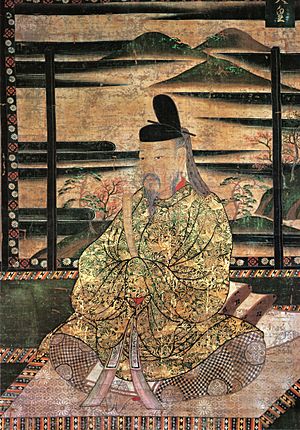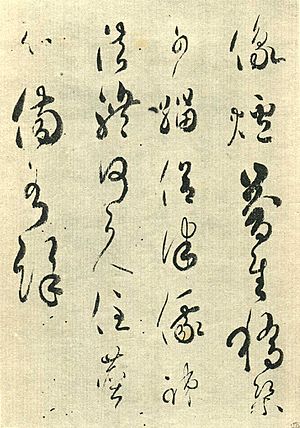Emperor Saga facts for kids
Quick facts for kids Emperor Saga嵯峨天皇 |
|||||
|---|---|---|---|---|---|
 |
|||||
| Emperor of Japan | |||||
| Reign | May 18, 809 – May 29, 823 | ||||
| Enthronement | May 30, 809 | ||||
| Predecessor | Heizei | ||||
| Successor | Junna | ||||
| Born | Kamino (神野) October 3, 784 |
||||
| Died | August 24, 842 (aged 57) | ||||
| Burial | Saga no yamanoe no misasagi | ||||
| Spouse | Tachibana no Kachiko | ||||
| Issue more... |
|
||||
|
|||||
| House | Yamato | ||||
| Father | Emperor Kanmu | ||||
| Mother | Fujiwara no Otomuro | ||||

Emperor Saga (嵯峨天皇, Saga-tennō, October 3, 786 – August 24, 842) was the 52nd emperor of Japan. He ruled from 809 to 823. Emperor Saga was known for his many talents and for helping to shape Japanese culture.
Contents
About Emperor Saga
Saga was the second son of Emperor Kanmu and Fujiwara no Otomuro. His personal name was Kamino. He was a very skilled writer and artist. He could write beautiful poems in Chinese. He also held the first poetry contests at the palace.
Legend says that Emperor Saga was the first Japanese emperor to drink tea. He is honored at his tomb in Kyoto. This tomb is called the Saganoyamanoe Imperial Mausoleum.
Key Moments in Saga's Life
- 806: Saga became the crown prince when he was 21 years old. This meant he was next in line to be emperor.
- June 17, 809: The previous emperor, Heizei, became ill and stepped down. Saga then became the new emperor.
Soon after becoming emperor, Saga also became ill. His older brother, Heizei, tried to start a rebellion. Heizei wanted to move the capital city back to Nara. But Emperor Saga wanted it to stay in Heian-kyō (modern-day Kyoto).
Forces loyal to Emperor Saga quickly stopped this rebellion. A famous general named Sakanoue no Tamuramaro led Saga's army. This event is known as the Kusuko Incident. It ended quickly, preventing a bigger war.
General Tamuramaro is still remembered today. In Aomori Prefecture, the annual Nebuta Matsuri festival celebrates him. Giant, colorful paper lanterns are carried through the streets. These lanterns show mythical figures. It is said that Tamuramaro used huge lanterns to trick and capture his enemies long ago.
- August 24, 842: Emperor Saga passed away at the age of 57.
Eras During Saga's Rule
The years of Emperor Saga's rule are known by different era names. These eras help historians keep track of time.
Emperor Saga's Legacy
Emperor Saga left a lasting mark on Japan. He is connected to one of Japan's most famous families.
The Minamoto Clan
In ancient Japan, there were four main noble families. One of these was the Minamoto clan, also known as Genji. Emperor Saga's descendants formed a branch of this clan called the Saga Genji.
One of Saga's sons, Minamoto no Tōru, is believed to have inspired a character. He might be the main character in the famous novel The Tale of Genji. This book is one of the world's first novels.
Support for Buddhism
Emperor Saga was a strong supporter of the Buddhist monk Kūkai. Kūkai founded the Shingon School of Buddhism. Emperor Saga helped Kūkai by giving him the Tō-ji Temple in the capital city. This temple became very important for the Shingon school.
Daikaku-ji Temple
Daikaku-ji is a beautiful Buddhist temple in Kyoto. It was originally Emperor Saga's home. Later, some emperors even ruled from here. The temple has an old artificial lake called Ōsawa Pond. It is one of the oldest Japanese garden ponds still existing from the Heian period.
The Saga Go-ryū school of ikebana (the art of flower arranging) is based at this temple. It is named in honor of Emperor Saga.
Family Life
Emperor Saga had many children. To keep the royal family from becoming too large, many of his children were given the surname Minamoto. This meant they would not be in line to become emperor.
His main wife was Empress Tachibana no Kachiko. She was also known as Empress Danrin.
- Their second son, Imperial Prince Masara, later became Emperor Ninmyō.
- They also had Imperial Princess Seishi, who married Emperor Junna.
Other notable children included:
- Imperial Princess Uchiko, who became the first Saiin (a special priestess) at the Kamo Shrine.
- Minamoto no Makoto and Minamoto no Tōru, who became important figures in their own right.
See also
 In Spanish: Saga Tennō para niños
In Spanish: Saga Tennō para niños

